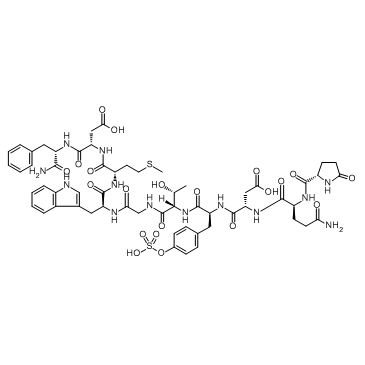Ceruletide (Caerulein) |
| Catalog No.GC30008 |
Céruléotide (Caerulein) est un décapeptide et un agoniste puissant des récepteurs de la cholécystokinine.
Products are for research use only. Not for human use. We do not sell to patients.

Cas No.: 17650-98-5
Sample solution is provided at 25 µL, 10mM.
Ceruletide, as a decapeptide and a potent cholecystokinetic agent, has a direct spasmogenic effect on the gallbladder muscle and bile ducts in humans and animals.[1]
In vitro experiment it indicated that at 1, 10, and 100 nmol/L, cerulein induced NF-kB–binding activity in a dose-dependent. But 0.3 nmol/L cerulein had no effect on activation NF-kappaB/Rel.[7]
In vivo, at a dose of 100 μg/kg, ceruletide decreased the rates of spontaneous locomotor activity and rearing, and also inhibited methylphenidate- and methamphetamine-induced hyperactivity in both sham-operated and vagotomized mice to same extent.[2] In vivo efficacy test it shown that rabbits were treated with 8 and 50 μg/kg of ceruletide decreased the plasma homovanillic acid levels, but had no significant differences. 140 and 200 μg/kg ceruletide had remarkable reduction of plasma homovanillic acid.[3] Ceruletide (100 μg/kg, s.c.) influenced the central dopaminergic system, enhanced the central effects of neuroleptics and had the potent therapeutic effects in the clinical trials.[4] In a mouse hypoxia model, treatment with 1-100 μg/kg ceruletide subcutaneously obviously prevented the CO-induced impairment of performance and the amelioration being correlated with the severity of hypoxia.[5] In addition, treatment with 10-300 μg/kg intraperitoneally ceruletide slightly but remarkably decreased the response rate (frequency of shuttles) under a discrete avoidance task in mice.[6]
References:
[1].Vincent ME, et al. Pharmacology, clinical uses, and adverse effects of ceruletide, a cholecystokinetic agent. Pharmacotherapy. 1982 Jul-Aug;2(4):223-34.
[2].Moroji T, Hagino Y. Bilateral subdiaphragmatic vagotomy does not prevent the behavioral effects of systematically administered ceruletide in mice. Neuropeptides. 1987 Apr;9(3):217-24.
[3].Wakata N, et al. Effect of ceruletide on plasma monoamine metabolites in the rabbit. J Neurol Sci. 1991 May;103(1):97-100
[4].Hagino Y, Moroji T. Effect of ceruletide on discriminated avoidance behavior in rats. Neuropeptides. 1987 Nov-Dec;10(4):335-42.
[5].Maurice T, et al. Cholecystokinin-related peptides, after systemic or central administration, prevent carbon monoxide-induced amnesia in mice. J Pharmacol Exp Ther. 1994 May;269(2):665-73.
[6].Kuribara H, et al. Effects of ceruletide, administered singly and in combination with central-acting drugs, on discrete shuttle avoidance response in mice. Jpn J Pharmacol. 1990 Nov;54(3):325-9.
[7].Steinle AU, et al. NF-kappaB/Rel activation in cerulein pancreatitis. Gastroenterology. 1999 Feb;116(2):420-30.
Average Rating: 5 (Based on Reviews and 26 reference(s) in Google Scholar.)
GLPBIO products are for RESEARCH USE ONLY. Please make sure your review or question is research based.
Required fields are marked with *




